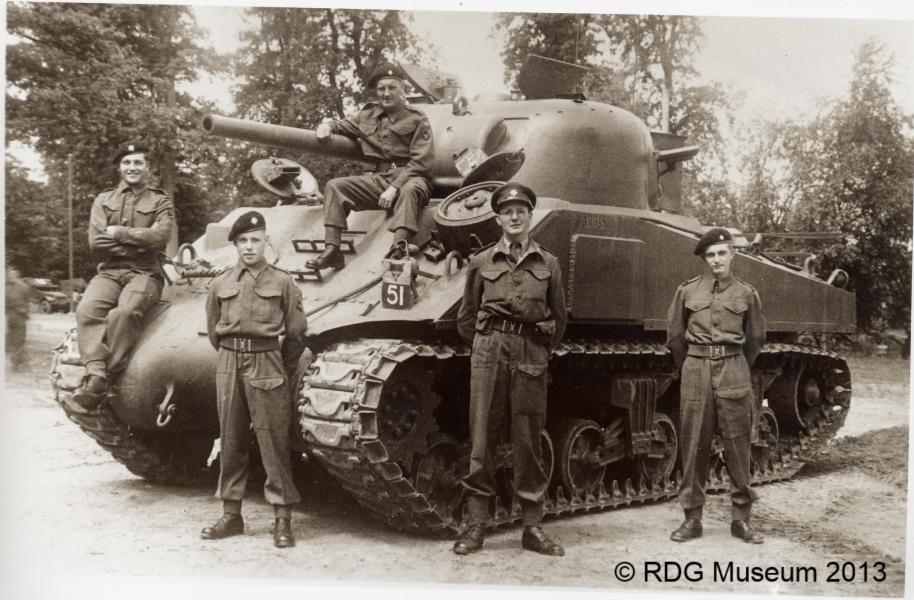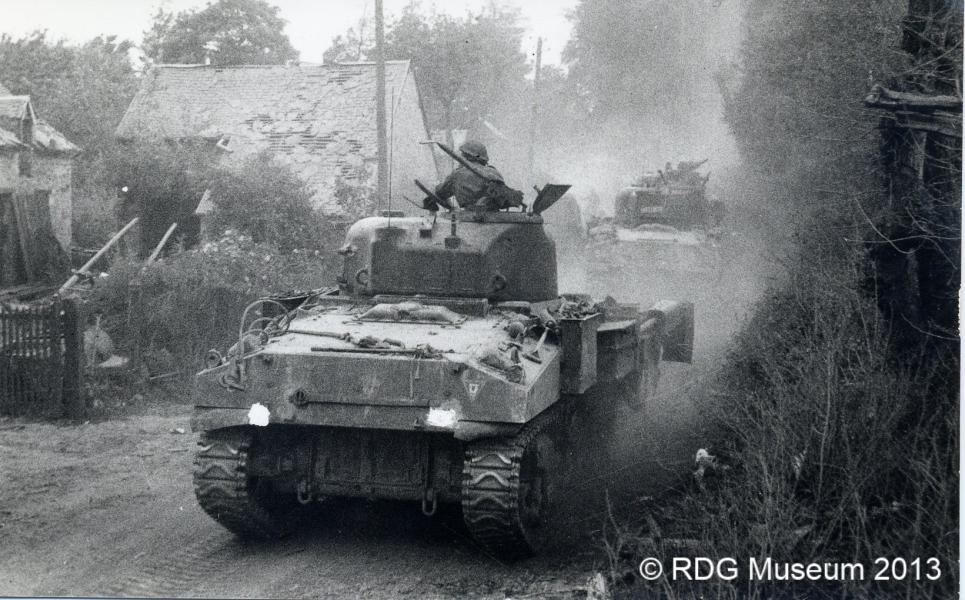

Prolifically produced, with more than 50,000 vehicles completed between 1942 and 1945, the M4 Sherman, in its various incarnations, served with the British, United States and Red (Soviet) Armies, in all theatres of the Second World War.

Above: An M4 Sherman of the 4th/7th Royal Dragoon Guards in France, 1944.
During its 50,000-unit production run, the US Army built seven principal variations of the M4 Sherman. These were the M4, M4A1, M4A2, M4A3, M4A4, M4A5, and M4A6. These variations did not represent a linear improvement of the vehicle, but rather references to changes in engine type, production location, or fuel type. As the tank was produced, a variety of improvements were introduced such as a heavier, high velocity 76mm gun, "wet" ammunition storage, a more powerful engine, and thicker armour.
In addition, numerous variations of the basic medium tank were built. These included a number of Shermans mounted with a 105mm howitzer instead of the usual 75mm gun, as well as the M4A3E2 Jumbo Sherman. Featuring a heavier turret and armour, the Jumbo Sherman was designed for assaulting fortifications and aiding in breaking out of Normandy. Other popular variations included Shermans equipped with Duplex Drive for amphibious operations, and those armed with the R3 flame thrower. Tanks possessing this weapon were frequently used for clearing enemy bunkers and earned the nickname "Zippos", after the famous lighter.
The Sherman entered combat in October, 1942, and was, at the time, superior to most Axis armoured vehicles. It provided a great boost in capability to British units so equipped, which had previously relied on 6-pounder armed variants of the Crusader cruiser tank, or the cumbersome and tall M3 Lee Medium tank. As the war progressed, however, German armour particularly began to outstrip the Sherman's capabilities. Even prior to the landings in Normandy, in June, 1944, it was found that the Sherman's 75mm gun was incapable of penetrating the frontal armour of the heavier German Panther and Tiger tanks; it struggled even against the frontal arc of the uparmoured Pzkpfw. IV Ausf. F2, G and H, known as the "Mk. IV Special". This led to the rapid introduction of the high velocity 76mm gun, initially on a limited scale, to Sherman units. Even with this upgrade, it was found that the Sherman was only capable of defeating the Panther and Tiger at close range, or by attacking from the flank. Using superior tactics, and working in conjunction with tank destroyers and air power, usually offered Allied tanks the best opportunities for destroying their heavier German counterparts. It was with these tanks that the 4th/7th Royal Dragoon Guards were equipped when they landed on Sword Beach on the 6th of June, 1944.
Below: M4 Sherman tanks of the 4th/7th Royal Dragoon Guards in action in Normandy, 1944.
The British Army, in order to ameliorate the problem of the Sherman's lack of killing power, also devised the Sherman Firefly: a modified M4, mounting the exceptionally powerful British 17-pounder gun as its main armament. This was capable of taking on the Panzers V and VI (Panther and Tiger), even across the frontal arc (the most heavily protected part of the tank); however, difficulties in design delayed the deployment of the Firefly, and limited British manufacturing capability meant that there were never enough to equip all British armoured regiments in Normandy. It was with a Sherman Firefly that Sgt. Harris of the 4th/7th Royal Dragoon Guards eliminated five (ordinarily difficult to kill) Panthers with five rounds in the village of Lingevres, on the 14th of June, 1944. The later introduction of APDS (Armour-Piercing Discarding-Sabot) ammunition further improved the killing power of the 17-pounder, making it one of the war's deadliest AT guns.
order to ameliorate the problem of the Sherman's lack of killing power, also devised the Sherman Firefly: a modified M4, mounting the exceptionally powerful British 17-pounder gun as its main armament. This was capable of taking on the Panzers V and VI (Panther and Tiger), even across the frontal arc (the most heavily protected part of the tank); however, difficulties in design delayed the deployment of the Firefly, and limited British manufacturing capability meant that there were never enough to equip all British armoured regiments in Normandy. It was with a Sherman Firefly that Sgt. Harris of the 4th/7th Royal Dragoon Guards eliminated five (ordinarily difficult to kill) Panthers with five rounds in the village of Lingevres, on the 14th of June, 1944. The later introduction of APDS (Armour-Piercing Discarding-Sabot) ammunition further improved the killing power of the 17-pounder, making it one of the war's deadliest AT guns.
By War's end, approximately some 17,000 US-built Shermans had been supplied to Britain under Lend-Lease, representing around 78% of total US Lend-Lease production. They had been used in all theathres of the war, from North Africa to the Far East. Sherman tanks would also see service in many conflicts after 1945, including the Korean War and the Middle East Wars, from the 1940s to the 1980s. Today, many survive in museums around the world.
 Above: M4 Sherman Firefly Medium Tank. Photo © Paul Hermans.
Above: M4 Sherman Firefly Medium Tank. Photo © Paul Hermans.